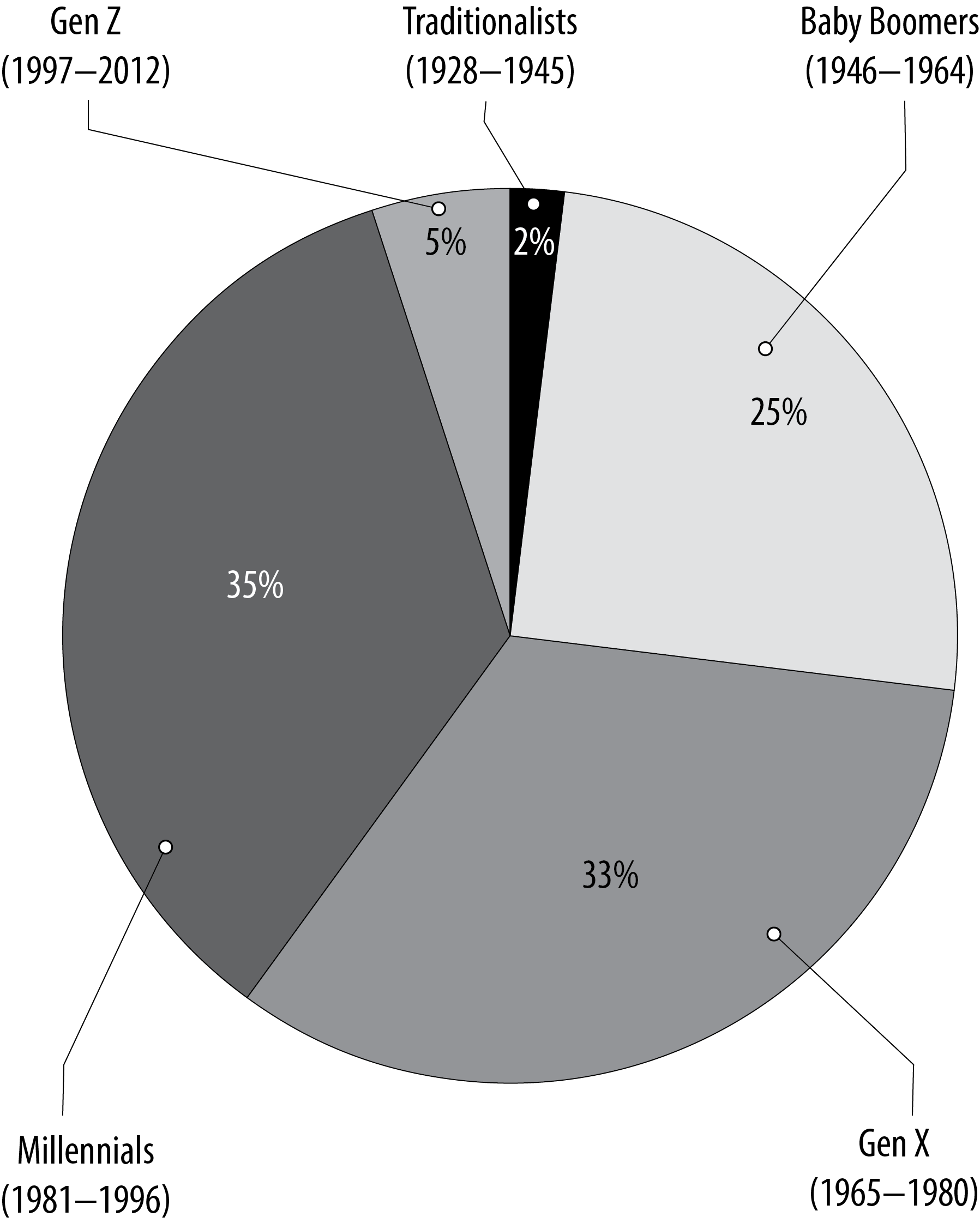Thriving in a Multigenerational Workplace
Today’s workforce is incredibly age-diverse. For the first time in history, there are five generations represented in the workplace, each with its own distinct set of values, beliefs, and motivations.
But what kind of challenges does this present for today’s employers? How do generational workforce differences affect our ability to work with and manage people effectively? And what are the traits, beliefs, and life experiences that mark each generation, influencing how they work, communicate, and respond to change?
Whether you’re a leader, manager, team member, or volunteer, it is important to understand what motivates those around you in the workplace. Taking the time to understand and appreciate how generations differ can help you create higher functioning teams and a more satisfying work environment.
Keep in mind, these key characteristics are not intended to stereotype individuals based on their generational group. Instead, they offer awareness of differences among the generations to empower leaders and teams to communicate and interact more effectively. Ultimately, getting to know each team member on an individual level will provide more insight on how to bring out the best in each of them.
This publication explains the values, beliefs, and worldviews of different generations and gives tips on how to best motivate and manage workers from each generation.
Traditionalists: Born 1928–1945
Generally, traditionalists, born between 1928 and 1945, tend to be dependable, straightforward yet tactful, and loyal. Events that helped shape their values and beliefs include the Great Depression and World War II. Radio and movies were their sources of news and entertainment.
While you don’t see many traditionalists in the workplace anymore, you may encounter them as volunteers or stakeholders.

When we examine what tends to motivate traditionalists, loyalty and respect rank high on the list. Recognition for efforts and a personal connection to others, even in the workplace, are also important. This generation firmly believes in an honest day’s pay for an honest day’s work.
When it comes to their worldview, traditionalists favor obedience over individualism. They equate age with seniority. They also believe in advancing in a company through an established hierarchy, rather than getting a promotion or position because of who you know. Because they are conformists and rule followers, traditionalists value job titles and secure pay.
From a leadership or management perspective, it’s important to provide traditionalists with satisfying work and opportunities to contribute while emphasizing stability.
Strengths
- Strong work ethic
- Experienced
- Disciplined
- Loyal
- Understand the chain of command
- Value tradition
- Avoid conflict
Tips for Coaching Traditionalists
- Show respect for their experience.
- Be honest, candid, and direct.
- Provide sufficient time and information regarding any upcoming changes.
- Use them as mentors to transfer knowledge and experience to younger generations.
- Provide recognition for their contributions.
- Continue to offer development opportunities.
Baby Boomers: Born 1946–1964
Ten thousand baby boomers reach retirement age every day. They make up approximately 33 percent of today’s workforce, and 65 percent of them plan to work past the age of 65. Boomers are optimistic, competitive, and team-oriented, and they are workaholics. Their worldview has been shaped by events such as the Vietnam War, Civil Rights Movement, and Watergate.
In general, they are motivated by company loyalty, teamwork, and a sense of duty. They believe that achievement comes after paying one’s dues and that sacrifice is necessary for success. This generation may prefer recognition in the form of monetary compensation or title recognition.
Boomers have a flexible communication style and will use whatever is most efficient, including phone calls and face-to-face interaction. Leaders and managers should provide them with specific goals and deadlines, put them in mentor roles, and offer coaching-style feedback.
Strengths
- Optimistic
- Dedicated
- Hardworking
- Good team players
- Respect for authority and hierarchical structure
- Experienced
Tips for Coaching Baby Boomers
- Treat them as equals. Ask for their opinion; don’t direct.
- Provide challenging and varied work assignments.
- Provide public recognition for their contributions.
- Show respect for their input, knowledge, and experience.
- Offer professional development opportunities.
- Use them as mentors to transfer knowledge and experience to younger generations.
Generation X: Born 1965–1980
Generation X (Gen X) is much smaller in total population size compared to baby boomers and Generation Y, yet they currently make up the highest percentage of people in the workforce—approximately 35 percent. Additionally, Gen Xers make up the highest percentage of start-up founders at 55 percent.
This sense of entrepreneurship and independence stems from a worldview that favors diversity and a need to change and evolve if their needs are not being met, both in their personal and professional lives. Gen Xers were shaped by life events such as the AIDS epidemic, the fall of the Berlin Wall, and the dot-com boom. They tend to be flexible, informal, and skeptical.
Gen X is also referred to as the “sandwich generation,” wedged between caring for their parents and raising their kids. This dual caregiving responsibility creates enormous stress, so they seek and are motivated by work-life balance and their personal or professional interests rather than the company’s interests.
Similar to baby boomers, Gen Xers are willing to communicate in whatever way is most efficient, including phone calls and face-to-face interaction. Supervisors and mentors should give Gen X employees and volunteers immediate feedback, provide flexible work arrangements to ensure work-life balance, and offer opportunities for personal development.
Strengths
- Independent and self-directed
- Ambitious
- Adaptable
- Technologically literate
- Challenge the status quo
Tips for Coaching Gen Xers
- Be approachable and encourage ideas.
- Provide challenging and varied work.
- Use performance-based rewards and promotion.
- Take time to personally engage and acknowledge them individually for contributions.
- Avoid micromanaging.
- Maintain two-way communication. Gen Xers want to interact and participate in decision-making.
- Help them see how their contributions achieve the organization’s goals.
- Be prepared to be flexible to allow them to balance family and work responsibilities.
Generation Y (Millennials): Born 1981–1996
This tech-savvy generation is currently the largest age group in the country and the fastest growing segment of today’s workforce. Shaped by events such as 9/11, the internet, and the housing market crash, approximately 15 percent of millennials ages 25–35 live at home with their parents.
Some millennials are content with selling their skills to the highest bidder. That means, unlike baby boomers, they’re not as loyal to organizations, but that doesn’t mean they’re not hard workers. While they may have no problem jumping from one organization to another, they tend to be competitive, civic-minded, open-minded regarding diversity, and achievement-oriented.
A culture of collaboration, flexibility, and lifelong learning is extremely important for millennials. Typically preferring to communicate via instant message, text message, and email, this generation seeks challenge, growth, and development. For success, get to know them personally, be flexible on their schedules and work assignments, and provide immediate feedback. Use measurable indicators for evaluation, feedback, and mentoring purposes, rather than vague generalities and ideas.
Strengths
- Good at multitasking
- Technologically savvy
- Achievement-oriented
- Confident
- Global worldview
- Like to have fun at work
Tips for Coaching Millennials
- Set ground rules early, particularly around technology use.
- Provide clear direction, support, and regular feedback.
- Provide people-skills training.
- Provide stimulation through a variety of roles in the team.
- Show openness to their ideas.
- Be flexible—find ways to allow them to pursue the activities they enjoy.
- Involve them in decision-making.
Generation Z: Born 1997–2012
Making up less than 5 percent of the current workforce, Generation Z (Gen Z) is right on the heels of millennials. Additionally, they account for 25 percent of America’s population, making this generation larger than baby boomers or millennials. Influenced by a range of life events, including post-9/11 terrorism and war, social networking, President Barack Obama, and climate change, Gen Z has grown up in a time of turbulence and instability mixed with hope for a better future.
Although the most technologically connected of all the generations, Gen Z is not necessarily tech-savvy. Despite this, their Gen-X parents raised Gen Z to be independent and able to figure things out for themselves. This means they may need less positive reinforcement than millennials.
This generation is motivated by diversity, personalization, social rewards, mentorship, and creativity. They also want to do meaningful work and be given responsibility. Like millennials and Gen Xers, they want flexible schedules.
What’s most intriguing about Gen Z is that 53 percent prefer face-to-face communication, despite seemingly being attached to their smartphones 24/7. For success with this generation, offer opportunities to work on multiple projects at the same time, provide them work-life balance, and allow them to be self-directed and independent.
Strengths
- Independent
- Problem-solver
- Good at multitasking
- Digitally connected
- Global-minded
- Pragmatic
Tips for Coaching Gen Z
- Provide clear direction, support, and regular feedback.
- Provide people-skills training.
- Provide stimulation through a variety of roles on the team.
- Provide challenging and varied work.
- Use performance-based rewards and promotion.
- Be flexible—find ways to allow them to pursue the activities they enjoy.
Summary
So how can you help ensure that your employees, coworkers, and even volunteers, regardless of when they were born, feel valued, empowered, and invested in? Follow these steps for success:
- Encourage cross-collaboration and mutual mentoring. While having employees from multiple generations within one organization may present some challenges, it also offers an opportunity for people with differing perspectives to learn from each other. Young people have an opportunity like no other time in history to offer their solutions to a problem while learning from their older colleagues.
- Prioritize flexibility. One of the core recommendations from human resources research is for leaders and managers to become adept at understanding what their people truly want and need. Recognize there is no one-size-fits-all solution for each generation or for all employees/volunteers in general. Adaptability is key, and this is where soft skills and emotional intelligence really come into play.
- Dispel generational stereotypes. There may be truths to certain stereotypes, but they also offer an incomplete picture and can be polarizing. If you hold fast to these stereotypes and attempt to coach employees and volunteers through a narrow lens, you risk putting them in a box and limiting opportunities for innovation and productivity. Generations can work in harmony if inaccurate perceptions are corrected. It is important to set your assumptions aside and take a human approach.
References
Brandman University. (2019). Overcoming the challenges of a multigenerational workforce.
Calhoun, A. (2020). Gen-X women are caught in a generational tug-of-war. The Atlantic.
Dimock, M. (2019). Defining generations: Where millennials end and gen z begins. Pew Research Center.
Lindzon, J. (2016). The problem with generational stereotypes at work. Fast Company.
Pew Research Center. (2015). Labor force composition by generation.
Rampton, J. (2017). Different motivations for different generations of workers.
Tanner, R. (2020). Generation Z: Who are they and what events influenced them? Management is a Journey.
University of Florida Training and Organizational Development. (n.d.). Leading across generations.
Publication 3521 (POD-10-23)
Reviewed by Michael Newman, PhD, Lecturer, Human Sciences, from an earlier version by Marina Denny, EdD, Extension Program and Staff Development Specialist and Assistant Professor, Human Sciences.
The Mississippi State University Extension Service is working to ensure all web content is accessible to all users. If you need assistance accessing any of our content, please email the webteam or call 662-325-2262.




